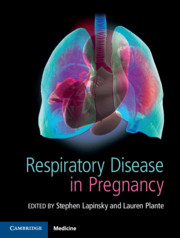Book contents
- Respiratory Disease in Pregnancy
- Respiratory Disease in Pregnancy
- Copyright page
- Contents
- Contributors
- Section 1 The Basics: for the Obstetrician
- Section 2 The Basics: for the Non-Obstetrician
- Section 3 Pulmonary Conditions Not Specific to Pregnancy
- Section 4 Pulmonary Conditions Related to Pregnancy
- Section 5 Other Pulmonary Issues in Pregnancy
- 19 Tobacco Smoking in Pregnancy
- 20 Radiological Imaging of the Chest in Pregnancy
- 21 Respiratory Drug Therapy in Pregnancy
- 22 Biological and Immunosuppressive Respiratory Therapy in Pregnancy
- 23 Oxygen Therapy during Pregnancy
- 24 Airway Management in Pregnancy
- 25 Mechanical Ventilation in Pregnancy
- Index
- References
22 - Biological and Immunosuppressive Respiratory Therapy in Pregnancy
from Section 5 - Other Pulmonary Issues in Pregnancy
Published online by Cambridge University Press: 14 April 2020
- Respiratory Disease in Pregnancy
- Respiratory Disease in Pregnancy
- Copyright page
- Contents
- Contributors
- Section 1 The Basics: for the Obstetrician
- Section 2 The Basics: for the Non-Obstetrician
- Section 3 Pulmonary Conditions Not Specific to Pregnancy
- Section 4 Pulmonary Conditions Related to Pregnancy
- Section 5 Other Pulmonary Issues in Pregnancy
- 19 Tobacco Smoking in Pregnancy
- 20 Radiological Imaging of the Chest in Pregnancy
- 21 Respiratory Drug Therapy in Pregnancy
- 22 Biological and Immunosuppressive Respiratory Therapy in Pregnancy
- 23 Oxygen Therapy during Pregnancy
- 24 Airway Management in Pregnancy
- 25 Mechanical Ventilation in Pregnancy
- Index
- References
Summary
Before prescribing in pregnancy it is important to understand the potential pharmacodynamic and pharmacokinetic changes of medications related to physiological changes in pregnancy, e.g. increased plasma volume, increased renal excretion, and also the bioavailability of the medication to the mother, fetus and infant through breastfeeding.
- Type
- Chapter
- Information
- Respiratory Disease in Pregnancy , pp. 200 - 209Publisher: Cambridge University PressPrint publication year: 2020
References
- 1
- Cited by



